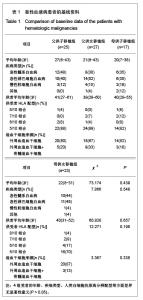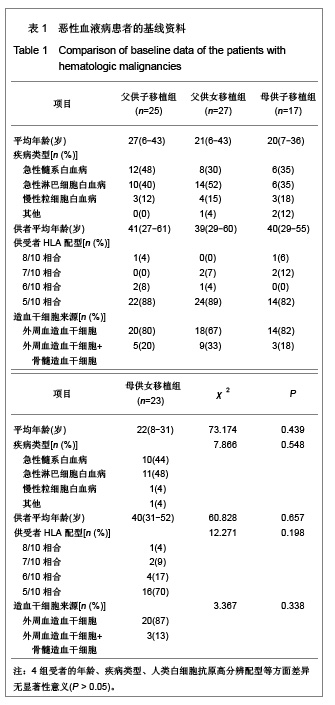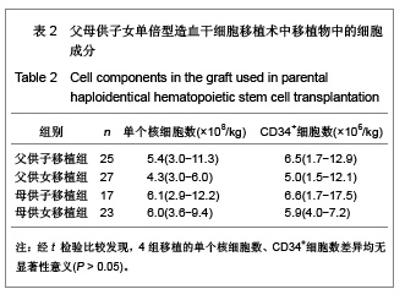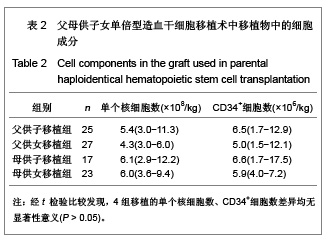Chinese Journal of Tissue Engineering Research ›› 2013, Vol. 17 ›› Issue (10): 1753-1760.doi: 10.3969/j.issn.2095-4344.2013.10.008
Previous Articles Next Articles
Parental haploidentical hematopoietic stem cell transplantation for treatment of hematologic malignancies
Wan Ding-ming, Shi Cong-cong, Xie Xin-sheng, Sun Ling, Sun Hui
- Department of Hematology, the First Affiliated Hospital of Zhengzhou University, Zhengzhou 450052, Henan Province, China
-
Received:2012-10-27Revised:2013-01-12Online:2013-03-05Published:2013-03-05 -
About author:Wan Ding-ming☆, Doctor, Professor, Chief physician, Master’s supervisor, Department of Hematology, the First Affiliated Hospital of Zhengzhou University, Zhengzhou 450052, Henan Province, China wwddmm@vip.sina.com
CLC Number:
Cite this article
Wan Ding-ming, Shi Cong-cong, Xie Xin-sheng, Sun Ling, Sun Hui. Parental haploidentical hematopoietic stem cell transplantation for treatment of hematologic malignancies[J]. Chinese Journal of Tissue Engineering Research, 2013, 17(10): 1753-1760.
share this article
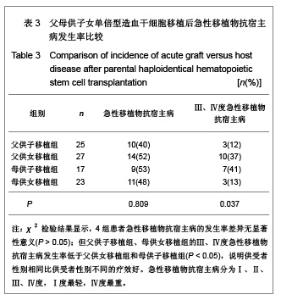
2.4 父母供子女单倍型造血干细胞移植治疗恶性血液病的植入情况 经红细胞表面抗原、染色体、微卫星标记检测,92例患者均获得完全植入。4组患者中性粒细胞≥0.5×109 L-1的中位时间分别为14 d(11-17 d)、14 d (9-19 d)、15 d(11-25 d)、16 d(10-23 d);血小板≥20×109 L-1的中位时间分别为18 d(10-40 d)、14 d (10-30 d)、20 d(11-34 d)、13 d(11-15 d)。经比较发现4组间粒系、巨核系造血重建时间差异均无显著性意义(P > 0.05)。 2.5 父母供子女单倍型造血干细胞移植后急性移植物抗宿主病的发生情况 急性移植物抗宿主病是指发生在移植后100 d以内,以皮肤、肝脏和胃肠道为主要表现的临床病理综合征[14]。急性移植物抗宿主病分为Ⅰ、Ⅱ、Ⅲ、Ⅳ度。经比较发现4组患者急性移植物抗宿主病的发生率差异无显著性意义(P > 0.05)。但4组Ⅲ、Ⅳ度急性移植物抗宿主病发生率差异存在显著性意义(P < 0.05);其中父供子移植组、母供女移植组的Ⅲ、Ⅳ度急性移植物抗宿主病发生率低于父供女移植组和母供子移植组(P < 0.05)。而父供子移植组和母供女移植组间及父供女移植组和母供子移植组间Ⅲ、Ⅳ度急性移植物抗宿主病发生率差异无显著性意义(P > 0.05),见表3。 2.6 父母供子女单倍型造血干细胞移植后慢性移植物抗宿主病的发生情况 在超过100 d的随访中,父供子移植病例中发生慢性移植物抗宿主病的患者8例,发生率32%,其中4例为广泛型。父供女移植组10例发生慢性移植物抗宿主病,累计发生率37%,广泛型3例。母供子移植组中6例发生慢性移植物抗宿主病,累计发生率35%,广泛型3例。母供女移植组中8例发生慢性移植物抗宿主病,累计发生率35%,广泛型2例。4组患者慢性移植物抗宿主病的发生率差异无显著性意义(P > 0.05)。"
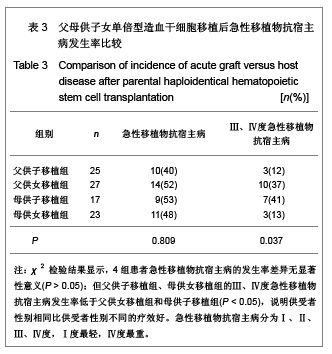
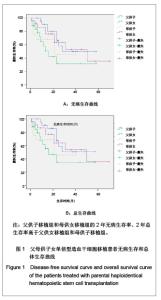
2.7 父母供子女单倍型造血干细胞移植后原发病复发情况 随访至2012年9月,父供子移植组中2例原发病复发,发生率8%,其中急性髓系白血病复发患者1例,经再次化疗、供者干细胞输注后持续缓解达18个月,急性淋巴细胞白血病 1例。父供女移植组3例复发(11%),其中急性淋巴细胞白血病1例,急性髓系白血病2例。母供子移植组2例患者原发病复发(12%),均为急性淋巴细胞白血病。母供女移植组2例原发病复发(9%),其中急性淋巴细胞白血病 1例,急性混合细胞白血病1例。经比较发现4组间复发率差异无显著性意义(P > 0.05)。 2.8 父母供子女单倍型造血干细胞移植后患者的生存情况 92例患者随访至2012年9月,随访中位时间20个月。 父供子移植组死亡9例,移植相关死亡7例(28%),16例无病存活,2年无病生存率为(67±11)%,2年总生存率为(68±11)%;父供女移植组死亡10例,移植相关死亡7例(26%),17例无病存活,2年无病生存率为(32±13)%,2年总生存率为(35±14)%;母供子移植组死亡5例,移植相关死亡4例(24%),11例无病存活,2年无病生存率为(45±20)%,2年总生存率为(46±20)%;母供女移植组死亡8例,移植相关死亡6例(26%),15例无病存活,2年无病生存率为(64±11)%,2年总生存率为(64±11)%;经比较发现4组间移植相关死亡率差异无显著性意义(P > 0.05),但4组间2年无病生存率、总生存率差异有显著性意义(P < 0.05)。其中父供子移植组和母供女移植组的2年无病生存率、2年总生存率高于父供女移植组和母供子移植组,且父供子移植组和母供女移植组间2年无病生存率、总生存率差异无显著性意义 (P > 0.05),见图1。"

| [1] Hart DP, Peggs KS. Current status of allogeneic stem cell transplantation for treatment of hematologic malignancies. Clin Pharmacol Ther. 2007;82(3):325-329.[2] Laughlin MJ, Barker J, Bambach B, et al. Hematopoietic engraftment and survival in adult recipients of umbilical-cord blood from unrelated donors. N Engl J Med. 2001;344(24): 1815-1822.[3] Lu DP. Blood and marrow transplantation in mainland China. Hong Kong Med J. 2009;15(3 Suppl 3):9-12.[4] Yuan HL, Jiang M, Wen BZ, et al. Zhonghua Qiguan Yizhi Zazhi. 2010;31(2):79-83. 袁海龙,江明,温丙昭,等.HLA单倍体相合与全相合外周血造血干细胞移植治疗恶性血液病的疗效比较[J].中华器官移植杂志, 2010,31(2):79-83.[5] Huang XJ. Current status of haploidentical stem cell transplantation for leukemia. J Hematol Oncol. 2008;1:27.[6] Wan DM, Zhang C, Xie XS, et al. Zhongguo Zuzhi Gongcheng Yanjiu yu Linchuang Kangfu. 2011;15(19): 3485-3488. 万鼎铭,张诚,谢新生,等.单倍型相合造血干细胞移植治疗高危白血病[J].中国组织工程研究与临床康复,2011,15(19):3485- 3488.[7] Ruggeri L, Mancusi A, Burchielli E, et al. NK cell alloreactivity and allogeneic hematopoietic stem cell transplantation. Blood Cells Mol Dis. 2008;40(1):84-90.[8] Zhang ZN, Shen T. Beijing: Science Press. 2008. 张之南,沈悌.血液病诊断及疗效标准[M]. 3版.北京:科学出版社, 2008.[9] Ji SQ, Chen HR, Wang HX, et al. G-CSF-primed haploidentical marrow transplantation without ex vivo T cell depletion: an excellent alternative for high-risk leukemia. Bone Marrow Transplant. 2002;30(12):861-866.[10] Chang YJ, Huang XJ. Use of G-CSF-stimulated marrow in allogeneic hematopoietic stem cell transplantation settings: a comprehensive review. Clin Transplant. 2011;25(1):13-23.[11] Wan DM, Kang YQ, Sun H, et al. Zhongguo Shiyong Neike Zazhi. 2009;29(7):648-649. 万鼎铭,康轶青,孙慧,等.改良BU/CY预处理方案行异基因造血干细胞移植治疗恶性血液病的临床研究[J].中国实用内科杂志, 2009,29(7):648-649.[12] Wan DM, Shao YL, Qin T, et al. Zhongguo Zuzhi Gongcheng Yanjiu. 2012;16(32):6076-6080. 万鼎铭,邵运丽,秦童,等. HLA单倍体与全相合异基因造血干细胞移植治疗恶性血液病[J].中国组织工程研究,2012,16(32): 6076-6080.[13] Wang Y, Liu DH, Xu LP, et al. Superior graft-versus-leukemia effect associated with transplantation of haploidentical compared with HLA-identical sibling donor grafts for high-risk acute leukemia: an historic comparison. Biol Blood Marrow Transplant. 2011;17(6):821-830.[14] Laughlin MJ, Barker J, Bambach B, et al. Hematopoietic engraftment and survival in adult recipients of umbilical-cord blood from unrelated donors. N Engl J Med. 2001;344(24): 1815-1822.[15] Kang Y, Chao NJ, Aversa F. Unmanipulated or CD34 selected haplotype mismatched transplants. Curr Opin Hematol. 2008; 15(6):561-567.[16] Chang YJ, Zhao XY, Huo MR, et al. Influence of lymphocyte recovery on outcome of haploidentical transplantation for hematologic malignancies. Medicine (Baltimore). 2009;88(6): 322-330.[17] Gyurkocza B, Rezvani A, Storb RF. Allogeneic hematopoietic cell transplantation: the state of the art. Expert Rev Hematol. 2010;3(3):285-299.[18] Henslee-Downey PJ, Abhyankar SH, Parrish RS, et al. Use of partially mismatched related donors extends access to allogeneic marrow transplant. Blood. 1997;89(10):3864-3872.[19] Rizzieri DA, Koh LP, Long GD, et al. Partially matched, nonmyeloablative allogeneic transplantation: clinical outcomes and immune reconstitution. J Clin Oncol. 2007; 25(6): 690-697.[20] Aversa F, Tabilio A, Velardi A, et al. Treatment of high-risk acute leukemia with T-cell-depleted stem cells from related donors with one fully mismatched HLA haplotype. N Engl J Med. 1998;339(17):1186-1193.[21] Ochiai N, Shimazaki C, Fuchida S, et al. Successful non-T cell-depleted HLA haplo-identical three-loci mismatched hematopoietic stem cell transplantation from mother to son based on the feto-maternal microchimerism in chronic myelogenous leukemia. Bone Marrow Transplant. 2002; 30(11): 793-796.[22] Wang Y, Wu DP, Sun AN, et al. Zhonghua Xueyexue Zazhi. 2006;27(12):842-844. 王荧,吴德沛,孙爱宁,等.母体内微量子代细胞嵌合体在HLA半相合造血干细胞移植中的意义[J].中华血液学杂志,2006,27(12): 842-844. [23] Tamaki S, Ichinohe T, Matsuo K, et al. Superior survival of blood and marrow stem cell recipients given maternal grafts over recipients given paternal grafts. Bone Marrow Transplant. 2001;28(4):375-380.[24] van Rood JJ, Loberiza FR Jr, Zhang MJ, et al. Effect of tolerance to noninherited maternal antigens on the occurrence of graft-versus-host disease after bone marrow transplantation from a parent or an HLA-haploidentical sibling. Blood. 2002;99(5):1572-1577.[25] Aversa F. Haploidentical haematopoietic stem cell transplantation for acute leukaemia in adults: experience in Europe and the United States. Bone Marrow Transplant. 2008; 41(5):473-481. [26] Huang XJ, Xu LP, Liu KY, et al. Partially matched related donor transplantation can achieve outcomes comparable with unrelated donor transplantation for patients with hematologic malignancies. Clin Cancer Res. 2009;15(14):4777-4783.[27] Xiang QQ, Kong PY, Li JP, et al. Jiefangjun Yixue Zazhi.2012; 37(2):121-125. 向茜茜,孔佩艳,李杰平,等.亲代间单倍体相合造血干细胞移植治疗血液病45例临床分析[J].解放军医学杂志,2012,37(2):121- 125.[28] Qu JH, Wen BZ. Linchuang Xueyexue Zazhi. 2008;21(11): 621-624. 曲建华,温丙昭.诱导造血干细胞胞移植免疫耐受的研究进展[J].临床血液学杂志, 2008,21(11):621-624.[29] Tong J. Guoji Mianyixue Zazhi.2007;30(1):23-27. 童娟.NK细胞在异基因造血干细胞移植中对移植物抗白血病效应及移植物抗宿主病作用的影响[J].国际免疫学杂志,2007, 30(1): 23-27.[30] Ruggeri L, Mancusi A, Capanni M, et al. Donor natural killer cell allorecognition of missing self in haploidentical hematopoietic transplantation for acute myeloid leukemia: challenging its predictive value. Blood. 2007;110(1):433-440.[31] Symons HJ, Leffell MS, Rossiter ND, et al. Improved survival with inhibitory killer immunoglobulin receptor (KIR) gene mismatches and KIR haplotype B donors after nonmyeloablative, HLA-haploidentical bone marrow transplantation. Biol Blood Marrow Transplant. 2010;16(4): 533-542. |
| [1] | Pu Rui, Chen Ziyang, Yuan Lingyan. Characteristics and effects of exosomes from different cell sources in cardioprotection [J]. Chinese Journal of Tissue Engineering Research, 2021, 25(在线): 1-. |
| [2] | Zhang Xiumei, Zhai Yunkai, Zhao Jie, Zhao Meng. Research hotspots of organoid models in recent 10 years: a search in domestic and foreign databases [J]. Chinese Journal of Tissue Engineering Research, 2021, 25(8): 1249-1255. |
| [3] | Wang Zhengdong, Huang Na, Chen Jingxian, Zheng Zuobing, Hu Xinyu, Li Mei, Su Xiao, Su Xuesen, Yan Nan. Inhibitory effects of sodium butyrate on microglial activation and expression of inflammatory factors induced by fluorosis [J]. Chinese Journal of Tissue Engineering Research, 2021, 25(7): 1075-1080. |
| [4] | Wang Xianyao, Guan Yalin, Liu Zhongshan. Strategies for improving the therapeutic efficacy of mesenchymal stem cells in the treatment of nonhealing wounds [J]. Chinese Journal of Tissue Engineering Research, 2021, 25(7): 1081-1087. |
| [5] | Liao Chengcheng, An Jiaxing, Tan Zhangxue, Wang Qian, Liu Jianguo. Therapeutic target and application prospects of oral squamous cell carcinoma stem cells [J]. Chinese Journal of Tissue Engineering Research, 2021, 25(7): 1096-1103. |
| [6] | Xie Wenjia, Xia Tianjiao, Zhou Qingyun, Liu Yujia, Gu Xiaoping. Role of microglia-mediated neuronal injury in neurodegenerative diseases [J]. Chinese Journal of Tissue Engineering Research, 2021, 25(7): 1109-1115. |
| [7] | Li Shanshan, Guo Xiaoxiao, You Ran, Yang Xiufen, Zhao Lu, Chen Xi, Wang Yanling. Photoreceptor cell replacement therapy for retinal degeneration diseases [J]. Chinese Journal of Tissue Engineering Research, 2021, 25(7): 1116-1121. |
| [8] | Jiao Hui, Zhang Yining, Song Yuqing, Lin Yu, Wang Xiuli. Advances in research and application of breast cancer organoids [J]. Chinese Journal of Tissue Engineering Research, 2021, 25(7): 1122-1128. |
| [9] | Wang Shiqi, Zhang Jinsheng. Effects of Chinese medicine on proliferation, differentiation and aging of bone marrow mesenchymal stem cells regulating ischemia-hypoxia microenvironment [J]. Chinese Journal of Tissue Engineering Research, 2021, 25(7): 1129-1134. |
| [10] | Zeng Yanhua, Hao Yanlei. In vitro culture and purification of Schwann cells: a systematic review [J]. Chinese Journal of Tissue Engineering Research, 2021, 25(7): 1135-1141. |
| [11] | Kong Desheng, He Jingjing, Feng Baofeng, Guo Ruiyun, Asiamah Ernest Amponsah, Lü Fei, Zhang Shuhan, Zhang Xiaolin, Ma Jun, Cui Huixian. Efficacy of mesenchymal stem cells in the spinal cord injury of large animal models: a meta-analysis [J]. Chinese Journal of Tissue Engineering Research, 2021, 25(7): 1142-1148. |
| [12] | Hou Jingying, Yu Menglei, Guo Tianzhu, Long Huibao, Wu Hao. Hypoxia preconditioning promotes bone marrow mesenchymal stem cells survival and vascularization through the activation of HIF-1α/MALAT1/VEGFA pathway [J]. Chinese Journal of Tissue Engineering Research, 2021, 25(7): 985-990. |
| [13] | Shi Yangyang, Qin Yingfei, Wu Fuling, He Xiao, Zhang Xuejing. Pretreatment of placental mesenchymal stem cells to prevent bronchiolitis in mice [J]. Chinese Journal of Tissue Engineering Research, 2021, 25(7): 991-995. |
| [14] | Liang Xueqi, Guo Lijiao, Chen Hejie, Wu Jie, Sun Yaqi, Xing Zhikun, Zou Hailiang, Chen Xueling, Wu Xiangwei. Alveolar echinococcosis protoscolices inhibits the differentiation of bone marrow mesenchymal stem cells into fibroblasts [J]. Chinese Journal of Tissue Engineering Research, 2021, 25(7): 996-1001. |
| [15] | Fan Quanbao, Luo Huina, Wang Bingyun, Chen Shengfeng, Cui Lianxu, Jiang Wenkang, Zhao Mingming, Wang Jingjing, Luo Dongzhang, Chen Zhisheng, Bai Yinshan, Liu Canying, Zhang Hui. Biological characteristics of canine adipose-derived mesenchymal stem cells cultured in hypoxia [J]. Chinese Journal of Tissue Engineering Research, 2021, 25(7): 1002-1007. |
| Viewed | ||||||
|
Full text |
|
|||||
|
Abstract |
|
|||||
